Keyword Strategy Case Study
How Our Sturdy Keyword Strategy Boosted Organic Traffic For This SaaS by 350%

How Our Sturdy Keyword Strategy Boosted Organic Traffic For This SaaS by 350%
SyndicationPro, the #1 Capital Raising and Investment Management Software, after raising a round of funding, was looking for a partner to scale organic lead generation and quality content production. Real Estate Sponsors manage billions in real estate assets using SyndicationPro.
Being a one-of-its-kind real estate investment management software in a rather niche market, and considering the popular ideology “Good Products Don’t Need Marketing”, leads should have been pouring in, but that was not the case. Here’s a glimpse of the challenges we’ll discuss:
In this case study, we’re going to discuss the exact strategies we implemented to boost the organic traffic of SyndicationPro without spending a single buck in paid advertising.
Different niches will definitely need different nuances but here are some key takeaways:
Our expectations were surpassed as our strategies began yielding exceptional results within months. Here’s a snapshot:
So Let’s Jump In!
Ruling the SERPs should’ve been easy since the market isn’t as fiercely competitive as it is a relatively small community of real estate syndicators but still Syndication Pro had sub-par organic rankings even for their relevant keywords which impacted the overall lead generation.
A FP-Growth Site Audit revealed the primary concerns we had to suit up for; the website ranked for a few keywords, out of which only for 3 were in the top 10 positions.

Our growth and operating partner also ranked for a few competitive keywords: real estate syndication software, investor portal, and how to syndicate a real estate deal.
Could it be better? Of course!
The traffic driven by these keywords was low at best, and there was potential for so much more. Here’s a glimpse of their organic traffic before we used our SEO spell:

Another point of concern was the <no index> tag that resulted in on-site blogs being almost completely invisible. Also, apart from Home Page, no other page was in the SERPs, which meant either that was the only page on their website (which sounds crazy) or there was something fishy!
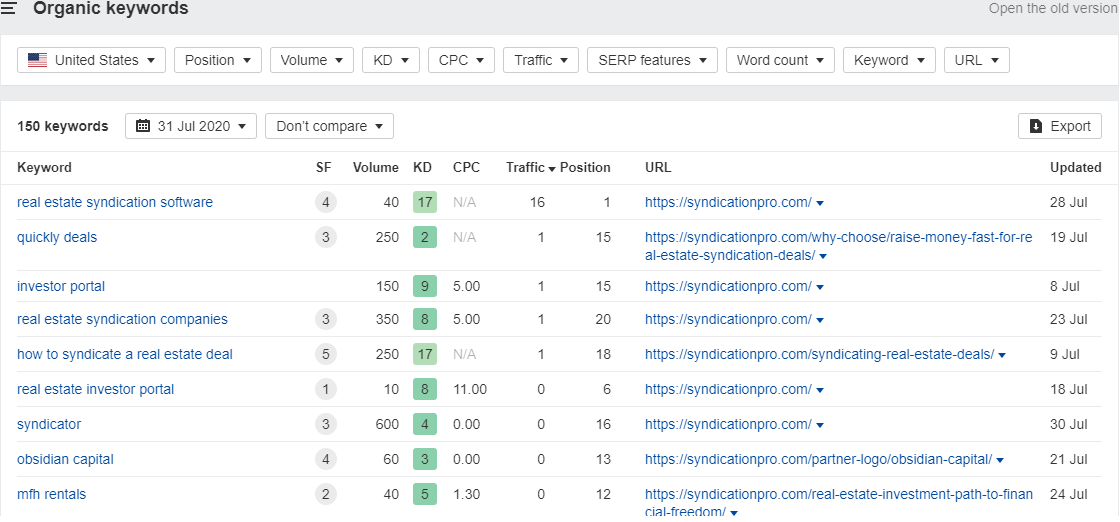
Moreover, they had just 2 keywords which showed on page one of Google and 3 for the top 10 positions and in all the 3 cases, Home Page was the only one ranking. No Bueno.

Most of the inner pages were as if invisible to the SERPs, which was due to a <No index> tag for some pages, especially the blog ones. This kept SyndicationPro afar from being a GO-TO place for investors and syndicators and they weren’t even in the “Battle to Become Real Estate Sifu”
Lack of visibility and low organic rankings were the sole reasons that kept SyndicationPro from becoming the #1 Real Estate Syndication Software and they were just a step away from donning “The Crown of Success” with pride.
Two words. Keyword Strategy.
You’re now about to DEEP DIVE into the complete process we used to not only create amazing content but also outrank our client’s global competitors.
Here’s a step-by-step guide of how we managed to boost our client’s organic web traffic by 350%, and how you can achieve the same for your business too:
For this, our site audit provided some great insights. We kick-started the process by the good old move of tracking their rankings for each keyword before implementing any changes to their website. Once we got a solid list of keywords, analyzed them (Tools we used: Keyword Planner, Keyword.io, Ubersuggest, Ahrefs, and SEMRush) and grouped them based on relevance.
We also removed the no-index tag from all the pages for which our tech team extended their support and we were able to rectify the issue within a day.
Although Real estate syndication software is a relatively niche market and there aren’t similar software out in the market we had to compete with, but ranking only for their “software” wasn’t going to work; our goal was to establish SyndicationPro as the GO-TO place for Investors and Syndicators and since the SERPs are filled with real estate masters and hundreds of competing blogs.

Now was the time to SUIT UP!
We had to build their “Resources” section strategically and had to choose topics to target wisely; evergreen topics built around untapped keywords. Interactive infographics, well-curated blogs and value-jammed podcasts were the key content types we focused on.
We enhanced our clients’ Keyword Strategy by focusing on long-tail keywords, low volume, and high intent and built a list of keyword opportunities. Our team also shortlisted a set of unique keywords, prepared a Google Sheet with over 1000 niche-focused keywords. Here’s a glance:
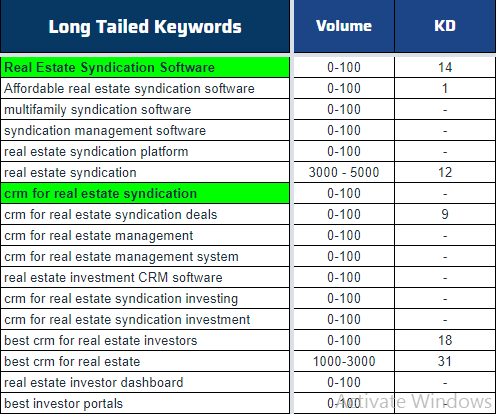
Here’s how you can prepare that:
Head over to the Keyword Explorer in Ahrefs and search some product or service related seed keywords, and since our client is targeting real estate industry –

We sorted the sheet based on competition, and picked medium traffic keywords with high intent and low competition and prepared a list of keywords we could target along with the rank we expected to rank for, here’s a snapshot:
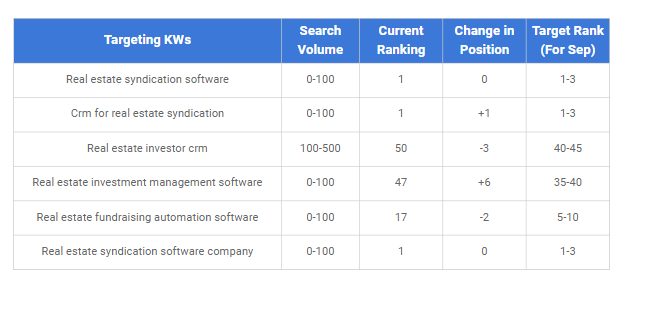
Another important part of keyword strategy is targeting a group of related keywords instead of focusing on just one, you can check it in the Keyword Ideas section.
To check what queries we could address with content, we checked the Questions part and added the terms based on Search Volume and Keyword Difficulty we selected a bunch of relevant keywords.

We selected the keywords we wanted to target and exported it as a CSV/Excel sheet, (you can also check Google AutoSuggest and Answer The Public for the same). You can also check “People Also Check” section:
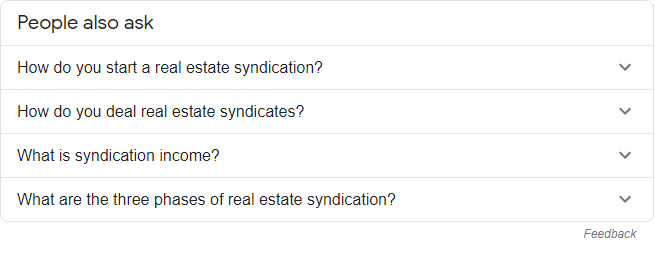
These are the exact questions their audience usually targets. These questions were added as new sections in our client’s blogs.
Once we had a solid list of primary and secondary keywords, the next step was to identify the terms we could rank in the top 5 positions for and we were pretty realistic here and we also leveraged competitive analysis.
Based on our thorough keyword research, we mapped various keywords and keyword variants specific to onsite content. We also focused on different keywords for different pages and ensured that each web page was positioned on the first page in SERPs, not just the Home Page. Before optimizing the onsite content we assessed their quality by taking a note of the following points:
Once we got a list of top ranking pages, we knew we had everything in place and now was the time to implement our strategies and crush the numbers.
We started with Content Optimization – Our content team optimized each page, blog, and infographics for specific targeted keywords by adding the keyword variants in the header tags, not the keyword stuffing way but wherever there was a dire need to make the content relevant. Here’s a peek at the top pages Syndication Pro ranks for right now:

Based on the keywords and keyword variants, our content team mapped important topics and subtopics to add in fresh content. When it comes to content, it’s quality over quantity, which is why focus on creating value-jammed content is important, as it can prove a great way to establish and build a backlink profile.
The final step in keyword qualification is assessing the type of content you intend to use these keywords in. From working on pillar content (content that ranks for more competitive terms and serves as an anchor on the site) to regular content update to implementing content syndication strategy (Guest Posts, Web 2.0, and Press Release), we left no stone unturned. While writing new content, we made sure our content was:
A keyword density of 3- 5% (target keyword appears about 1-2 times/100 words) was maintained across all the pages to avoid readability errors.
Although On-page elements have a small impact, they still influence rankings, it helps Google understand what the page is about – relevance of the content, keywords targeting and quality of the content.
For our client, we tweaked the:
Also, it’s not the Primary Keyword you can use, but secondary keywords (LSI – synonymous keywords) can be used as well. Here’s a glimpse:

Since Google can’t read images including target keywords in alt text can help it understand.
While implementing the aforementioned points, remember, don’t stuff keywords, place them wherever it’s possible and wherever it seems natural.
One of the easiest way to funnel traffic and make sure their site visitors stayed on their webpages was adding relevant, useful links wherever possible:

As simple as it sounds, internal links are often ignored by companies, despite the fact that it’s a great way to strengthen their authority, and also it literally takes only 5 seconds. To add valuable internal links, here’s what you need to do:

Proper and relevant internal links were added to ensure every page is accessible to crawlers so that pages aren’t invisible to Google and other search engines.
Having worked with top-notch SaaS companies in the past, we knew that to achieve position #1 we need to build high-quality backlinks with relevant and top-ranking domains, so we focused on that for a while.
We started the process by analyzing our client’s competitors backlink profile (that’s a treasure), and checking which domains have linked to their content. We prepared a list of such referring pages and domains (with strong Domain Authority) and mapped the links with our client’s relevant content pieces. Here’s how you can generate a list:


Check for Do-follow links, preferably; this will give you a list of domains you can reach out with your optimized content. You can also check the keywords they are targeting with their content (add-on to your keyword strategy)
Shortlist 25+ similar links with keywords to get you started
You can also check the Link Intersect report by adding your competitors to check if they are linked to the domain you intend to target. If they have, there might be a higher chance of them backlinking with your website as well.
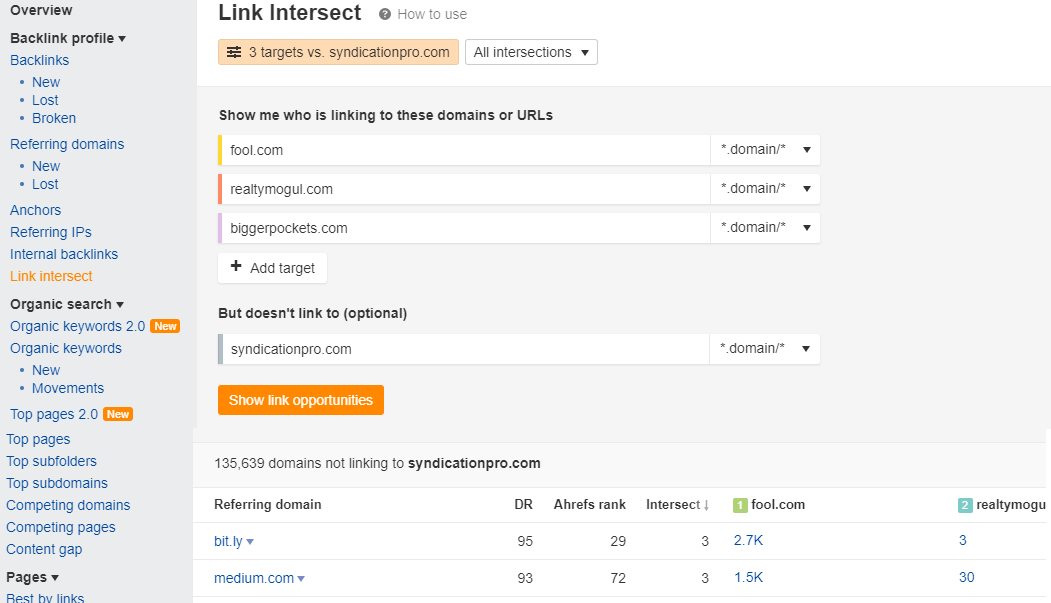
A random search shows the opportunities SyndicationPro can leverage that the other companies are using already (Note: The companies mentioned above are not the competitors of SyndicationPro).
Once you have a list of over 100 sites in place, you can start an outreach campaign and send a personalized email to these sites sharing the content they might be interested in.
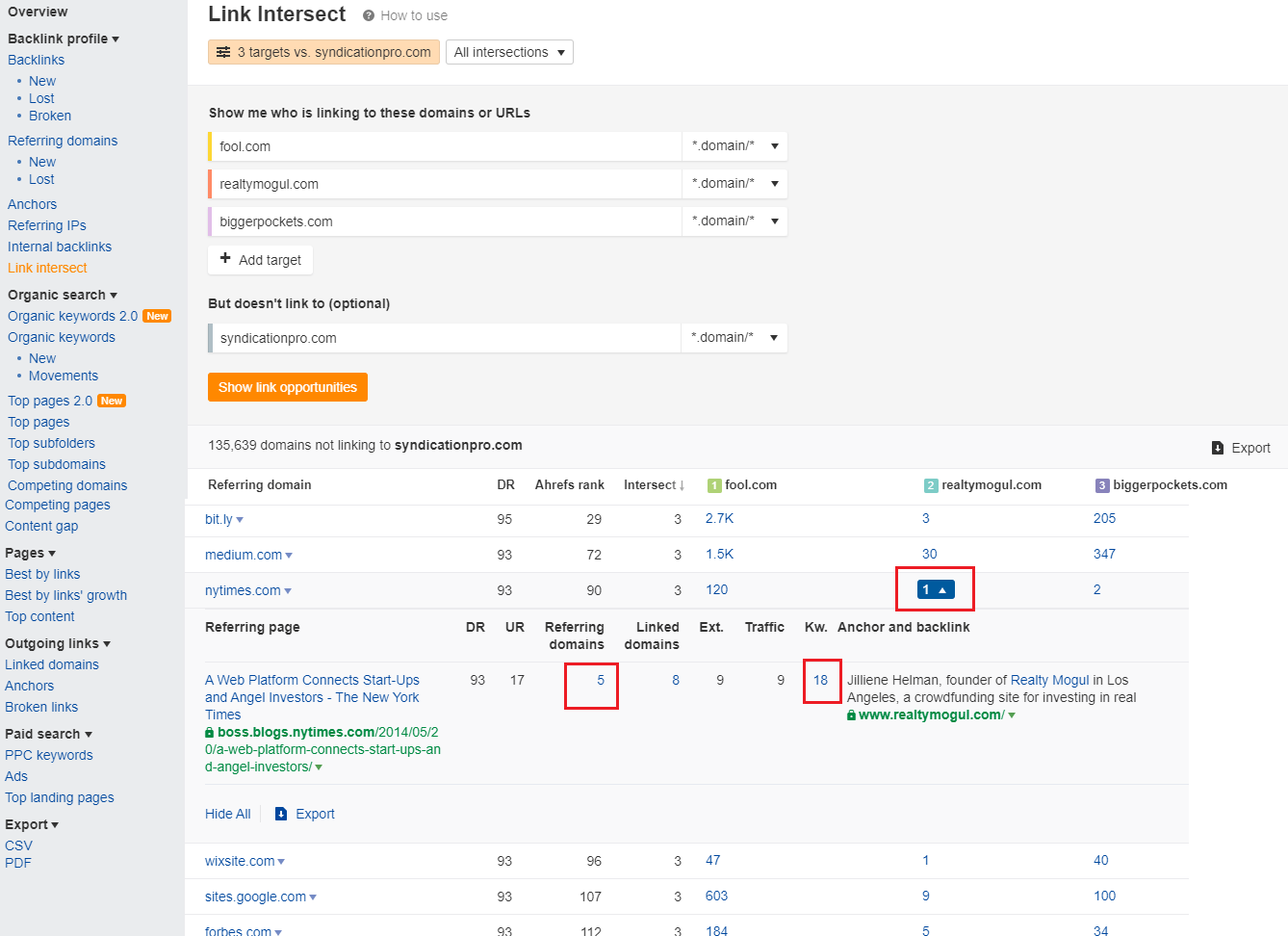
The data extracted from here can aid in your keyword strategy as well as help you prepare a list of websites you can build backlinks with. Here’s a snapshot of results our efforts yielded for SyndicationPro.

Key points we focused on while building backlinks:
Regular content updation (Google loves up-to-date content) and implementing content syndication – republishing blogs, articles, and infographics on third party sites (Guest Posts, Web 2.0, and Press Release) were the pillars of our content promotion strategy. Content was also promoted actively across Social Media platforms to build authority and establish them as PROS of the real estate industry.
Additionally, with the thought of leaving no stone unturned, we analyzed most visited platforms of our client’s target audience and provided solutions for recurring problems so they know who they can turn to. Key platforms include – Biggerpockets, Medium, etc.
This helped us boost referral traffic, which according to Google plays an important role in determining page rank.
We were overwhelmed to see that our estimated rankings turned out to be wrong. For some keywords we estimated to rank our client was surprised to see that they now rank amongst the top 5 positions.
Our “Keyword Strategy Soup” worked like an immune-boosting tonic and improved our client’s website health score.
Starting out, SyndicationPro ranked 47 for the keyword “real estate investment management software” and currently it’s on position #9 and ranked 17 for “real estate fundraising automation software” and currently it’s on position … drumroll… #1.

Remember the famous quote, “Everyone has to fight their own battles”? That’s exactly what the inner web pages of SyndicationPro are doing right now. They are back in the battle and are competing against real estate pros for competitive keywords and rank on page 1. From 150 organic keywords to 289, our keyword strategy worked wonders for our client.

Keyword Strategy is the heart of SEO and the strategies implemented need to be tweaked now and then for better results and to ensure their alignment with Google’s stubborn algorithm.
As our keyword strategy started showing results (keywords SyndicationPro ranks for increased by 75.3%), our clients were able to boost their organic web traffic by 350%.
Amazing, right?
Our client was so overjoyed with the results that they now call us “SEO WIZARDS”, and we think we deserve the title!
If you want to rule all of the SERP realms and rank for your target topics, get in touch with us today!
Actionable insights and learnings about building and scaling SaaS companies
At FP Growth, we empower our people to express ideas that drive success. Our open and collaborative work culture motivates our people towards building their dream career.
I’m Happy to join!